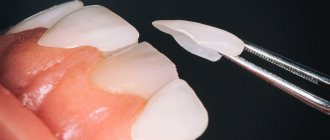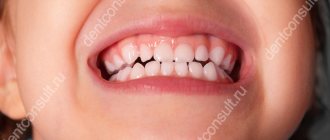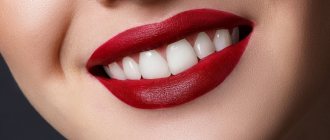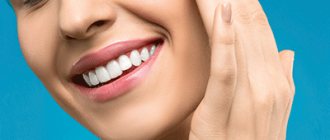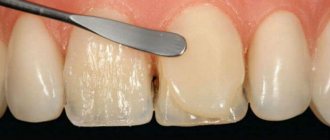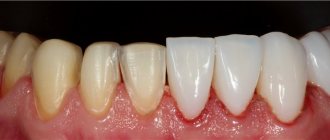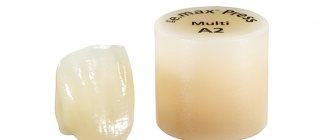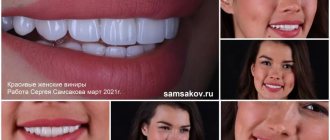In the age of selfies, video conferencing and presentations, a smile takes on special significance. Beautiful, straight and snow-white teeth – this is the beauty standard of the 21st century. But what should you do if your teeth are not so straight and their color leaves much to be desired?
Special thin overlays on teeth – veneers – come to the rescue. They mask dental defects, and the colors of dental veneers can be selected taking into account individual preferences.
Veneering is a correction of a smile using thin overlays on the teeth.
Veneering allows you to:
- hide chips and cracks;
- camouflage pigment spots;
- visually enlarge small teeth;
- cover gaps between teeth.
An important advantage of veneers is the ability to change the color of teeth.
How to choose the color of veneers
Choosing the right shade for the overlays is perhaps the most important part of the process. You can make veneers ideal in shape, carefully convey the details, but without the right color you will not get a satisfactory result.
Teeth onlays are made from materials that have properties as close as possible to natural enamel. This means that they have (to a greater or lesser extent) the ability to transmit light - to shine through. Therefore, the color of the dentin (the layer under the enamel) will be reflected in the final color of the plate. The shade of the cement on which the veneer is fixed will also make its contribution.
The colors of ceramic veneers are selected using the Vita scale
. In total, it contains 20 colors: 16 of them are natural, and 4 are ultra-white (Bleach). Bleach is an unnatural color; there are no natural teeth of this color.
There are 4 blocks in the scale, each with its own shade:
- Block A
includes red-brown shades - Block B
- yellow-red - Block C
- grayish - Block D
- gray-red
Decoding shades shouldn't be scary. In fact, they all look like natural enamel, and the designations are only important for specialists.
The main characteristic of color is brightness. Therefore, each block presents 4 degrees of brightness of each shade. From the brightest, it is indicated by the number 1, to the dimmer, under the number 4. The color of the veneer is a1
means that it should be the brightest color in the reddish-brown range. There are no shades in the bleach color of veneer 1 or 2, only white. There is a certain amount of yellow in Bleach 3 and 4, but the entire palette immediately speaks of the artificial origin of the color.
Aspects of Shade Determination
When consulting with a doctor on the issue of prosthetics and whitening of dental elements with cosmetic plates, it is recommended to carry out a comparative analysis procedure using the standard Vita palette.
Particularly popular today are instruments from the leading company Ivoclar Vivadent , which offers dental clinics innovative products to achieve the most effective and aesthetic results. The palette from this manufacturer includes the most natural white shades.
In the absence of such a device, dentists often resort to computer technology, the potential of which also makes it possible to correctly select the color of teeth in accordance with the downloaded digital photo of the patient.
However, despite the capabilities of programmable electronic computing devices, practical experience has shown that a visual comparison of shade matching produces a more effective and accurate result, especially since such a procedure can be carried out in any dental clinic.
Important! The shade of an element of the dentition is determined by three points - the cervical area, the middle of the crown, and the incisal edge. Careful assessment of color in all these areas is very important because... the enamel surface on different parts of the crown has different tones.
The color difference is influenced by the condition of the gum tissue, the dental unit itself and the structure of the enamel.
In order for the result of prosthetics to please the patient and not raise questions and dissatisfaction regarding the discrepancy between the comparison of shades and the result, the procedure for choosing the optimal color should be carried out under certain conditions, namely:
- Double teeth cleaning . Before visiting the doctor, the patient must perform thorough hygienic teeth cleaning. The doctor performs a control cleansing in his office using a special composition.
- Daylighting. The selection of shade is carried out only in natural light. Artificial light sources emit predominant shades, so determining the color of teeth will have errors.
Illumination is measured using a lux meter. Optimal values are 1200-1400 lux. Many dentists' offices are equipped with solar light units.The brightness of the lighting on such systems is adjustable, thereby creating optimal conditions for assessing the color of teeth.
- Suitable decoration for a dental office. The white tint reflects more than it absorbs.
In order to correctly assess the natural color of teeth, the interior of the office should not be too intense (saturated) in color, attracting a lot of unnecessary attention. It is desirable that the walls have a calm color in light colors.
Various elements of clothing can also distort the result of selecting a shade; for this reason, before selecting the most suitable color of veneers, it is important to take into account all factors that can affect the matching results.
- Proper hydration of teeth. The dry protective layer of teeth has weak light reflectivity compared to wet surfaces, so this detail is also important to take into account.
- Emotional state of the dental client. Most experts are inclined to believe that the natural perception of the shade of the elements of the dentition is influenced not only by external factors, but also by the mental state of the patient.
Therefore, one of the main tasks of a doctor is to provide a comfortable and mutually supportive environment.
For reference! Ceramics are close to tooth enamel in all properties. Veneers made from this material have excellent optical, structural, mechanical, biological and strength characteristics. Such products are also capable of transmitting, reflecting and absorbing light.
The secret of the popularity of zirconium veneers and their service life.
In this publication, we will find out how long teeth hurt after installing veneers.
Here https://www.vash-dentist.ru/protezirovanie/nesemnyie-p/viniryi-np/duo-pch-estestvennaya-krasota.html all the most important things about Duo PCH veneers.
Emax veneer color
Emax glass ceramics differ in their properties. Therefore, 3 parameters are used to designate its shades. Color scale, Vita 3D Master, includes:
- Brightness
_ Measured on a scale from 1 to 5 - Tone
. R – reddish, L – yellowish and M – intermediate - Saturation
. Use numbers from 1 to 3.
Thus, the color code consists of 3 symbols, 2 numbers and one letter.
Classic B1 for Emax is designated as 1M1.
The color palette in 3D Master is wider. It includes 26 natural shades and 3 ultra-white (Bleach).
Contraindications
Despite the versatility and practicality of the technique, there are limitations to the installation of veneers. For example, the use of plates is contraindicated in cases of bruxism, the presence of inflammatory processes, bone tissue pathology, and malocclusion.
Also, ceramic veneers are not used for the restoration of severely damaged teeth (more than 50%). In this case, the doctor installs crowns.
A refusal to carry out the procedure may be the presence of bad habits (biting nuts, nails, opening bottles with teeth, etc.). Or a high risk of maxillofacial injury. For example, extreme sports.
Gum disease and loss of chewing teeth will also require preliminary treatment before installing plates.
The most popular colors
Bright shades are the most popular. Most often, patients choose shades a1, a2 and b1. These teeth look natural, but at the same time immediately attract attention with their color. Bleach is the choice of popular people. In the spotlight, on the TV screen, bright white teeth look attractive. It’s not for nothing that these colors are called “Hollywood white.” In real life, such shades hurt the eyes a little.
In what cases are plates installed?
The main purpose of onlays is to eliminate aesthetic defects on the front teeth. It can be:
- Chips and cracks.
- Previously installed fillings that have changed color or cracked.
- Interdental gaps and tooth pigmentation that cannot be eliminated by professional cleaning.
- Pathological abrasion of enamel.
In addition, ceramic veneers help correct minor changes in the bite, crooked teeth, and a decrease in the volume of gum tissue.
Difficulty of choice
The choice of color depends on the number of restorations. For single teeth, it is important to choose a shade so that the restored tooth does not stand out. If the plates cover the entire visible dentition, then everything depends on the wishes of the patient. However, the dentist should explain the main approach to how to choose the color of veneers:
- Skin, hair and eye color
must be taken into account . The lighter the skin and hair, the less the teeth, even radically white ones, will stand out. - Eyes and teeth
are the first things people pay attention to. Dentists recommend choosing shades that match the whites of your eyes. - The size of the veneers
plays a role. Ultra-white colors visually enlarge the veneers, so for large teeth it is better to choose natural-colored veneers.
Nature or whiteness
Everyone knows: if you want to correct the shade, shape and size of your teeth, get veneering, which will help you look ten years younger.
How does this happen? As we age, the skin, body and bone organs of the mouth undergo aging. Teeth wear down and their appearance changes for the worse. They become short in length, which disrupts the paths of the canines and incisors. The facial muscles begin to work incorrectly, reducing chewing efficiency.
To protect the patient from the formation of facial and statistical folds, wrinkles in the nasolabial area, and to ensure a beautiful smile line, specialists add height and volume to the elements of the dentition if they are deficient.
Much attention is paid to nature and whiteness. All of these factors have a positive effect on appearance: the patient looks younger than his age.
Many patients with naturally soft tooth enamel want to whiten them several shades with the help of veneering so that their smile will be snow-white, like a movie star.
Experts do not recommend overdoing it, because excessive whiteness can not decorate, but ruin the overall appearance. Best the enemy of the good.
If you look deeply into this issue, the beauty of a smile is characterized by several parameters:
- the color of each element of the dentition;
- the location of each unit in the dental arch;
- the shape of all elements.
It is clear that a snow-white tooth with a clean surface, standing exactly in its place in a row, without defects, has a more attractive appearance in comparison with an uneven unit, yellowed from bacterial colonization.
In the absence of pronounced flaws, the color of the bone organs of the oral cavity is much more important, since it catches the eye of others more quickly. And, as you know, by the condition of the teeth, others determine a person’s trustworthiness, neatness, presentability, state of health, and physical capabilities.
But deliberate snow-white teeth will not add attractiveness, because it creates a feeling of insincerity, pretense, deception, something artificial, unreal.
For this reason, patients are increasingly puzzled by the issue of unnatural looking teeth after veneering.
Remarkable! In recent years, snow-white teeth are rapidly going out of fashion. A dazzling white smile cannot be found in nature and cannot be achieved through careful hygiene. The trend is an emphasis on natural color - the pristine whiteness of teeth, given to a person since childhood.
In the dental industry this problem can be solved today. To make it easier to accurately select the color that best matches the shade of the protective layer of the patient’s teeth, doctors have developed a special color scale.
This special table of tooth color perception in alphanumeric format greatly simplifies the work of the dentist when installing veneers.
Recommendations for caring for veneers to extend their service life.
Come here to take a closer look at Snap on smile veneers.
At this address https://www.vash-dentist.ru/protezirovanie/nesemnyie-p/viniryi-np/chto-takoe-polevoshpatnyie.html we will talk about the features of making feldspathic veneers.
What helps you choose the color of veneers
- Illumination
. The room should be adequately lit. Bright light encourages you to choose lighter shades, dim light encourages you to choose darker shades. - Removing plaque
. Professional teeth cleaning lightens them slightly, which affects the choice of shade. - Lack of bright colors
in the area where the selection takes place. Bright lipstick, makeup, and clothing details can disrupt color perception. - Wet surface
of teeth. The shade of moistened teeth is the most accurate.
Large clinics, such as ROOTT MCDI, use digital smile technology - Digital Smile Design
. The patient can see the results of the treatment even before it begins. This makes choosing the color of the overlays much easier and reduces frustration. If there is no such technology in dentistry, then the sample is brought to the teeth and a photo is taken to evaluate the appearance.
Care
Despite the fact that the material for making veneers was selected taking into account the effects of the alkaline environment of the oral cavity, sudden changes in temperature (hot drinks, ice cream, environmental influences, chewing loads), it is advisable not to forget that even real tooth enamel cannot withstand such loads and begins to collapse.
In this regard, you need to remember to care for veneers in order to extend their shelf life and preserve the original color. Moreover, veneers do not require special care; daily teeth brushing and infrequent visits (1-2 times a year) to the dentist are sufficient.
Additional conditions of care include some restrictions:
- Avoid drinking very hot drinks and ice cream
- Do not bite nuts or peel seeds.
- Limit your consumption of strong tea, coffee, as well as other drinks and products that contain persistent pigment, since traces of pigmentation tend to accumulate over time.
Sources used:
- Abolmasov N. G., Abolmasov N. N., Bychkov V. A., A. Al-Hakim “Orthopedic dentistry”, M., 2003
- THE BRITISH SOCIETY FOR RESTORATIVE DENTISTRY. "CROWNS, FIXED BRIDGES AND DENTAL IMPLANTS GUIDELINES"
- Notes of a good dentist / E.G. Aghajanyan. - M.: Omega, 2011.
Composite veneers
The color of composite veneers is able to convey the shade of natural enamel. But the type of finished product largely depends on the skill of the doctor. Since the composite is applied in layers, the dentist uses different shades, from darker to lighter, and the result is an imitation of a natural tooth. Composites are strong, they are used for veneers and restoration of dental crowns, but they are inferior in strength to ceramics.
Photopolymer overlays fade over time
, so the initial shade should be lighter than the desired one. When installing composite veneers, you should keep in mind not only the price, but also the service life. It is several times shorter for composites than for ceramics, including due to the fact that composites change color.
Benefits and harms
It is important to understand that the pros and cons of veneers directly affect the quality of your bite. Thus, without much effort, you can visually correct minor imperfections and ensure a whiter and brighter smile. And this is without grinding down the incisor, only with the removal of a thin layer of enamel. If all the rules are followed, the plate will need to be replaced only after 10-20 years - the positive effect is obvious.
On the other hand, abandoning them after the first fixation is already problematic. You have to wear them for the rest of your life, periodically lightening them or putting on new ones. Why? Because 0.5-0.7 of the natural protective coating has already been removed. And the same premolars under microprostheses may ache, because after dental treatment they will become more sensitive and will react more sharply to hot and cold food.
So you should carefully weigh the pros and cons before deciding to have your smile corrected.
Manufacturers
To protect yourself from low-quality prosthetics, check with the clinic about what materials are used in the procedure. Mainly large companies specialize in the production of ceramic veneers. There aren't many of them.
The most famous company Nobel Biocare is a leader in implantology and prosthetics. It was this manufacturer that developed the popular protocols for implantation procedures All-on-4, All-on-6, Trefoil, etc. In the case of installing veneers, the company specializes in the production of zirconium plates.
The list includes German and Japanese companies that produce their products under the brands Katana, Prettau and BruxZir Anterior. The leader in the production of pressed and solid ceramics is Ivoclar Vivadent, which specializes in Emax technology.
Many years of experience, modern materials and strict quality control allow these companies to occupy a strong position in the dental materials market.
Diagnostics
The fixation of ceramic plates is carried out in three stages: preparation for the installation of veneers, production of the structure and fixation on the teeth.
Correctly performed diagnostics determines how long the orthopedic structure will serve the patient. In addition to the condition of the teeth, it is important to identify possible hidden pathologies in the bone and soft tissues of the jaw. And also carefully study the anatomical structure of the teeth being restored.
At EspaDent clinics, specialists conduct radiographic examinations for more accurate diagnosis. In complex cases, a modern 3D tomograph is used, which creates three-dimensional, layer-by-layer images of both jaws. During a consultation in our clinics, the doctor will offer the best options for microprostheses and immediately indicate the cost of the procedure.
Scope of application of the Vita scale
Using a basic color chart, the dentist can identify the “native” shade of a person’s teeth or detect, if any, possible color defects. The fact is that the same tooth color looks different in people with different skin colors. For example, an unpleasant yellow tint is masked if a person returns from vacation very tanned, and then his smile appears white. However, the Vita scale helps to adequately assess the clinical picture. Such a tool is important in several dental fields.
The Vita scale is often used in the following situations:
- professional teeth cleaning with ultrasound and Air-flow: after ridding the patient of plaque, the hygienist must make sure that he has restored the natural color of the crowns. In addition, the Vita scale can be used before the procedure to conduct a comparative analysis of the effect of tartar on the color of crowns and to develop an individual oral care program for a particular person (this may include both nutritional correction and the cessation of bad habits, the use of certain brands of dental pastes and even brushes),
- for whitening in the clinic: laser, intracanal, photo bleaching, chemical bleaching. The doctor needs the palette to determine how many shades the enamel needs to be whitened, whether the result will look unnatural and whether it will lead to negative consequences, especially if the patient wants a snow-white smile, but the condition of his crowns does not allow him to achieve such a shade. In addition, during the procedure, the doctor should check the result so as not to overdo it,
- dental restoration: in the presence of chips, cracks and other surface defects, it is important that the filling, crown or microprosthesis are not noticeable on natural dental tissues.
Reviews
Modern advances and the emergence of new materials in dentistry have helped thousands of patients fulfill their dream - to get a beautiful smile, and therefore get rid of embarrassment when communicating with others.
Several solutions have been found to restore your teeth to their attractiveness. The most popular method today is veneering. But in order for the veneers to be in harmony with your own teeth and not distort the general opinion about your appearance, it is important to choose the right color.
You can talk about your experience of restoring teeth using veneers, as well as share your opinion on the effectiveness of the process, by leaving a comment on this article.
If you find an error, please select a piece of text and press Ctrl+Enter.
Tags veneers fixed dentures
Did you like the article? stay tuned
No comments yet
Price issue
The cost of ceramic veneers is influenced by the material, installation method, and complexity of the procedure. As well as the qualifications of the doctor and the reputation of the clinic. On average, prices for pressed ceramics start at 23 thousand rubles. Zirconium ones will cost 35 thousand and more, composite ones - from 10 thousand rubles.
If after diagnosis the patient needs dental treatment, the final cost will be higher.
At EspaDent clinics, the patient learns the final amount immediately after the initial diagnosis. No surcharges or hidden fees. For expensive procedures, our patients have the option of interest-free installments. Diagnostics and initial examination in all EspaDent clinics are free of charge.


